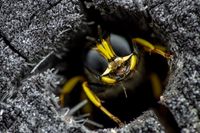...more Photos, more Stories...
This archaic-looking creature with the brute claw arms is a whip spider (Amblypygi). Over 200 species are distributed worldwide, almost all of which are native to tropical and subtropical forests. The first pair of legs of these fascinating animals is greatly elongated and is used as a whip-like feeler to track down prey or obstacles. Prey is grabbed with the pedipalps converted into tentacles. The Amplygi have no venom glands, but it also seems unlikely that prey, once caught, could escape. With their flattened bodies, it is easy for them to hide under stones and lie in wait for prey. I photographed the animal shown in Cahuita, Costa Rica when I and my guide Chris climbed a creek at night to look for snakes and frogs. The body length is approx. 20 mm.
On my first visit to Costa Rica I accompanied Chris on his "Tarantulas Way" tour, which takes place in the evenings along a path near the Cahuita National Park. On a banana tree we discovered this basilisk resting on a leaf stem. In order to be able to take photos with my macro setup, I have to get within a few centimeters of the subject, which is often a challenge with living animals in the wild. So I asked Chris, "What do you think, will I get close enough to take a usable photo?" Chris checked the immediate area for any dangers (poisonous snakes, nettles etc ...) and replied: "Try it!"
I grabbed the plant stem with my left hand and very carefully pulled it towards me until I could get close enough with my camera in my right hand. And I actually managed to get several photos that I was later able to combine to form this image using manual focus stacking. The male mosquito that soaks up the mineral-rich tear fluid was a welcomed bonus.
And the moral of the story? First: "If you don't dare, you won't win!" I never thought it would be possible to get that close to a reptile without chasing it away until I tried it.
And second: "Always have a Chris with you who makes sure that your enthusiasm doesn't end with a visit to the doctor!"
Patience, or maybe a bit of stubbornness, is one of the qualities a wildlife macro photographer should bring to be successful. I watched this digger wasp crawl into a wild bee nesting aid in one of the holes. Since I am fascinated by these extraterrestrial looking wasps, I really wanted to make a portrait of her and sat down in front of the place where she was hiding. With the camera focused on the opening, I sat there for over an hour and waited for the animal to show itself. Several times I had to put the camera down to loosen up my muscles, but the moment finally came. Now just don't screw up the exposure or focus and snap some quick photos hoping some will be on point. Viewed and wiped away in two seconds on instagram or facebook, but it took over two hours to create this a photo.
The subadult male of the "Viciria praemandibularis" jumping-spider. Khao Sok, Thailand.
The adult male of the "Viciria praemandibularis" jumping-spider. Khao Sok, Thailand.
The last molting of a jumping spider often brings about a dramatic change in the appearance of the spider. On the first picture a subadult male of the species "Viciria praemandibularis" can be seen, recognizable by the thickening of the pedipalps (the tactile organs next to the jaw). I took this photo in the evening on a solitary banana tree. The day after next I visited this plant again and photographed the adult male of the same species that can be seen in the second picture. The intense red color and the almost transparent legs suggest that the last molt took place shortly before. So there is a high probability that the photos show the same individual before and after the final molt.




